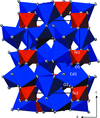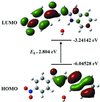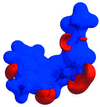issue contents
November 2018 issue

Cover illustration: A new solvatomorph has been obtained for the well-known non-steroidal anti-inflammatory drug sodium naproxen crystallizing with 1.5 methanol molecules. The crystal packing contains two types of coordination polyhedra around sodium with coordination numbers of six and seven. Methanol molecules participate in these distorted polyhedra and in O-H O hydrogen-bonding interactions with carboxylate O atoms. See: Krieger, Weil & Jones [Acta Cryst. (2018). E74, 1624-1627].
O hydrogen-bonding interactions with carboxylate O atoms. See: Krieger, Weil & Jones [Acta Cryst. (2018). E74, 1624-1627].
research communications
Download citation


Download citation


Heterometallic Co/Cd solvatomorphs, which differ by half of the solvent water molecule, show a remarkable variation in the cadmium coordination sphere.
CCDC reference: 1869534
Download citation


Download citation


In the crystal, the NiII complex cation and fumarate anion are located on individual inverse centers and linked via O—H⋯O, N—H⋯O and C—H⋯O hydrogen bonds.
CCDC reference: 1579677
Download citation


Download citation


The title molecule is comprised of two non-coplanar benzene rings connected by an imino group in a trans-configuration. In the crystal, the molecules are linked via O—H⋯N and C—H⋯O hydrogen bonds, forming chains along [101].
CCDC reference: 1843910
Download citation


Download citation


The title molecule is composed of fused ten-, five- (lactone), and three-membered (epoxide) rings. The lactone ring shows a flattened envelope-type conformation and bears a 2-aminobenzylidene substituent that is disordered over two conformations. The ten-membered ring has an approximate chair–chair conformation. There are no conventional hydrogen bonds, but there are a number of weaker C—H⋯O-type interactions.
CCDC reference: 1869537
Download citation


Download citation


A new crystalline phase of the radical ion salt octamethylenetetrathiafulvalenium triiodide is reported. The synthesis in THF, the crystal structure and the Hirshfeld surface analysis are described and the new modification, designated as δ-(OMTTF +)(I3−), is compared with the three previously known forms.
+)(I3−), is compared with the three previously known forms.
CCDC reference: 1871276
Download citation


Download citation


The crystal structures of four (E) -methoxybenzaldehyde oxime derivatives, namely (2-methoxybenzaldehyde oxime, 1, 2,3-dimethoxybenzaldehyde oxime, 2, 4-dimethoxybenzaldehyde oxime, 3, and 2,5-dimethoxybenzaldehyde oxime, 4, are discussed. The arrangements of the 2-methoxy group and the H atom of the oxime unit are s-cis in compounds 1–3, but in both independent molecules of compound 4, the arrangements are s-trans. The primary intermolecular O—H(oxime)⋯O(hydroxy) hydrogen bonds generate C(3) chains in 1 and 2. In contrast, in compound 3, the O—H(oxime)⋯O(hydroxy) hydrogen bonds generate symmetric  (6) dimers. A more complex dimer is generated in 4 from the O—H(oxime)⋯O(hydroxy) and C—H(2-methoxy)⋯O(hydroxy) hydrogen bonds.
(6) dimers. A more complex dimer is generated in 4 from the O—H(oxime)⋯O(hydroxy) and C—H(2-methoxy)⋯O(hydroxy) hydrogen bonds.
Download citation


Download citation


A new modification of Cd3TeO6, denoted as the β-form, has been structurally determined, adopting the rhombohedral Mg3TeO6 structure type.
CCDC reference: 1872058
Download citation


Download citation


The crystal structure of [Cd(C13H18NO3)2(C12H8N2)] is non-centrosymmetric. Two complex molecules with similar bond lengths and angles are present in the asymmetric unit, each exhibiting a distorted octahedral N4O2 coordination environment around the CdII ion.
CCDC reference: 1534691
Download citation


Download citation


The asymmetric unit contains two independent molecules and two water molecules. The central parts of both the molecules are twisted as both molecules are bent at both the S and N atoms. The crystal structure features N—H⋯N, N—H⋯O, C—H⋯O and O—H⋯O intermolecular interactions. Two-dimensional fingerprint plots show that the largest contributions to the crystal stability come from O⋯H/H⋯O and H⋯H interactions.
CCDC reference: 1869597
Download citation


Download citation


The title compound, C17H17NO2, was synthesized and its photoreactive properties in the crystalline state were investigated. A solid-state photoreaction did not occur because the reaction sites were too far apart in the molecule.
CCDC reference: 1870320
Download citation


Download citation


In this condensed 1,4-dihydropyridine derivative, which exhibits metabolism-regulating activity, the 1,4-dihydropyridine ring adopts a flattened boat conformation while the cyclohexenone ring is in an envelope conformation. Molecules in the crystal are assembled into chains along the a-axis direction via N—H⋯O hydrogen bonds.
CCDC reference: 1872194
Download citation


Download citation


In the title compound, the dihedral angles between the 1-methyl indole units (A and B) and the benzoic acid moiety (C) are A/B = 64.87 (7), A/C = 80.92 (8) and B/C = 75.05 (8)°. An intramolecular C—H⋯O interaction arising from the methyne group helps to establish the conformation. In the crystal,  (8) carboxylic acid inversion dimers linked by pairs of O—H⋯O hydrogen bonds are observed.
(8) carboxylic acid inversion dimers linked by pairs of O—H⋯O hydrogen bonds are observed.
CCDC reference: 1871874
Download citation


Download citation


Two independent samples of the title compound were studied using Cu Kα and Mo Kα radiation as part of a continuous crystallization study. In the crystal, chains along the a axis are formed via N—H⋯O hydrogen bonds between acetamide groups, as well as C—H⋯O interactions. These chains arrange themselves into parallel running stacks which display weak C—Cl⋯O=Chalogen bonding as well as weak C—H⋯π interactions.
Download citation


Download citation


The title molecule adopts an s-cis configuration with respect to the C=O and C=C bonds. The dihedral angle between the indole ring system and the nitro-substituted benzene ring is 37.64 (16)°. In the crystal, molecules are linked by O—-H⋯O and N—H⋯O hydrogen bonds, forming chains along [010]. In addition, weak C—H⋯O, C—H⋯π and π–π interactions further link the structure into a three-dimensional network.
CCDC reference: 1846181
Download citation


Download citation


The title compound, C13H16N2O4, consists of a six-membered unsaturated ring bound to a five-membered pyrrolidine-2,5-dione ring and N-bound to a six-membered piperidine-2,6-dione ring and thus has the same basic skeleton as thalidomide, except for the six-membered unsaturated ring substituted for the aromatic ring.
CCDC reference: 1872551
Download citation


Download citation


In the molecular structure of the title compound, two dihydrofuran and two tetrahydrofuran rings as well as one piperidine ring are fused together. In the crystal, molecules are linked by C—H⋯O and C—H⋯F hydrogen bonds, forming a three-dimensional network.
CCDC reference: 1872524
Download citation


Download citation


Crystal structure of 5,15-dihexyl-5,15-dihydrobenzo[2,1-b:4,3-c′]dicarbazole hexane 0.375-solvate
In the title compound, two helicenes form a porous structure with molecules of hexane inserted into the holes.
CCDC reference: 1873208
Download citation


Download citation


The synthesis and crystal structure of 5,10,15,20-tetrakis α,α,α,α 2-isothiocyanatophenyl zinc(II) porphyrin are reported. The crystal structure consists of discrete porphyrin complexes that are located on a twofold rotation axis with the ZnII cation in a square-pyramidal coordination environment defined by the porphyrin N atoms at the basal sites and a diethyl ether molecule at the apical site.
CCDC reference: 1872076
Download citation


Download citation


The crystal structures of (E)-N′-(benzylidene)-4-chlorobenzenesulfonohydrazide (I) and its ortho- and para-methyl-substituted benzylidene derivatives, (E)-N′-(2-methylbenzylidene)-4-chloro-benzenesulfonohydrazide (II) and (E)-N′-(4-methylbenzylidene)-4-chlorobenzenesulfonohydrazide (III), have been studied to investigate the effect of substitution on the structural and supramolecular features of these compounds.
Download citation


Download citation


The monohydrated chloride, bromide and iodide salt forms of the amino acid L-asparagine form an isostructural series.
Download citation


Download citation


A new solvatomorph of sodium naproxen with methanol as solvent is reported. The asymmetric unit comprises two formula units of sodium naproxen and three methanol molecules.
CCDC reference: 1873620
Download citation


Download citation


The title compound is nearly planar with a dihedral angle of 10.6 (4)° between the two benzene rings.
CCDC reference: 1864935
Download citation


Download citation


The single epimer of Dianin's compound analogue, (R)-4-(4-hydroxyphenyl)-2,2,4-trimethylthiachroman-1-oxide, was prepared by multiple recrystallization and studied by X-ray diffraction.
CCDC reference: 1872666
Download citation


Download citation


Study of the crystal structures of the title compounds reveals that the solid-state photochemical nitro–nitrito linkage isomerization is restricted by intermolecular C—H⋯O,O contacts in the 3-hydroxypyridine phase.
Download citation


Download citation


The reaction of [IrIII{C(dppm)2-κ3P,C,P′}ClH(NH3C2)]Cl with ethyl diazoacetate, a well known C=C coupling reagent, leads to the formation of a C=C unit, accompanied by N2 abstraction, and reorganization of a dppm subunit and, considered as a whole, to the transformation of the PCP pincer carbodiphosphorane system to a phosphorus ylide ligand. After removal of the halogenides, the iridium center is stabilized by the carbonyl O atom through the formation of a five-membered chelate ring. A PCO pincer ligand system is thereby generated, which coordinates the iridium(III) atom threefold in a facial manner. The addition of carbon monoxide causes a replacement of the carbonyl O atom of the acetate subunit by a carbonyl ligand.
Download citation


Download citation


The dihydroqinoxalinone portion of the molecule is planar to within 0.0512 (12) Å. In the crystal, a combination of C—H⋯O and C—H⋯N hydrogen bonds together with slipped π-stacking and C—H⋯π(ring) interactions lead to the formation of chains extending along the c-axis direction. The chains are linked into layers parallel to the bc plane by sets of four C—H⋯O hydrogen bonds and the layers are tied together by complementary π-stacking interactions.
CCDC reference: 1873385
Download citation


Download citation


The title compound was prepared by a template method starting from manganese(II) nitrate with a Schiff base ligand. The product of condensation was between methyl carbazate and glyoxylic acid, and formed in situ in aqueous solution containing ammonium thiocyanate. The manganese compound crystallized in the monoclinic space group P21/n and exists as a centrosymmetric dimer.
CCDC reference: 1870123
Download citation


Download citation


Transition-metal amidine complexes of the type MCl2[c-C3H5—C≡C—C(NR′)(NHR′)]2 (M = Mn, Fe, Co) are readily available by a two-step synthesis starting from cycloproplacetylene.
Download citation


Download citation


A new amide moiety bearing an imidazolium salt as precursor to an N-heterocyclic carbene was synthesized. The synthetic procedure, the compound's characterization and its crystal structure, including a comparison of geometrical parameters with related compounds, are reported and discussed.
CCDC reference: 1832439
Download citation


Download citation


The asymmetric unit of the title compound consists of two independent molecules differing slightly in the conformations of the seven-membered rings and the butyl substituents.
CCDC reference: 1874203
Download citation


Download citation


The semicarbazone derivative molecule is almost planar. In the crystal, the molecules are linked by O—H⋯O, N—H⋯O and O—H⋯N hydrogen bonds.
CCDC reference: 1865663
Download citation


Download citation


Description and comparison of the crystal structure of (Ni(1,2–bis(diphenylphosphanyl)ethane)2)(CF3SO3)2 at 100 K with its nitrate and bromide analogues.
CCDC reference: 1874698
Download citation


Download citation


The crystal structure of the title salt, (C6H16N)2[MoO4], results from N—H⋯O hydrogen-bonded rings formed through interconnections between the (iPr2NH2)+ cations and [MoO4]2− anions.
CCDC reference: 1874215
Download citation


Download citation


In the crystal structure of the title compound, binuclear centrosymmetric molecules are present. The FeIII cation exhibits a trigonal–bipyramidal environment, being coordinated by three Cl ligands in the equatorial plane and two P atoms of symmetry-related PCHP ligands at the axial sites. The complex molecules are linked into layers by intermolecular C—H⋯Cl hydrogen bonding.
CCDC reference: 1874120


 journal menu
journal menu




















































